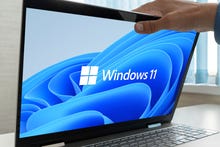How Do I Upgrade to Windows 10 Again
When you upgrade a PC to Windows 11, you have the option to hit a big Go Back push button (Settings > System > Recovery) and restore your previous Windows 10 installation. Merely y'all only have 10 days to practise that choice; the clock starts ticking as soon as you cease the Windows 11 install, and when you reach the x-twenty-four hours milestone, those rollback files are permanently deleted.
My colleague David Gewirtz discovered this setting last week, and hoo boy, I am here to tell y'all he did not like information technology one bit. The 10-mean solar day limit is "bonkers," he wrote, adding that information technology is "ridiculous and capricious [and] seems completely random." And and then he speculates as to the reason. "Why? Only considering."
Somewhere in Redmond, I am certain, the product managers in charge of Windows xi upgrades are reading that and pounding their heads on a desk in frustration.
Is that default setting new? Nope. For more than five years, that's been the rollback rule for every Windows x feature update.
Is it capricious?Of course, it is. There's no right or incorrect number of days, and yous could probably brand a case for extending the deadline to 14 days, or 21 days, or even 30 days (which is what the rollback menstruum was for Windows x from its initial release in 2022 until the arrival of the Windows 10 Anniversary Update in July 2016).
Come across also:Windows 11: Here's how to get Microsoft's free operating system update.
But is that really a skilful thought? As Mr. Gewirtz noted, "there may be reasons why a rollback from a major Windows upgrade might not exist possible." Indeed, with each day that passes after a major upgrade, the likelihood that a rollback will cause bug increases. Yous've installed new software, updated drivers, tweaked settings, and otherwise mucked about just enough to ensure that trying to go back to the status quo ante will be a less-than-positive experience.
Microsoft product managers hate it when their customers have an unpleasant experience.
And, of class, those uninstall files have up multiple gigabytes of deejay space that you might need for other purposes.
As those poor, quietly sobbing Microsoft product managers will tell you, telemetry data confirms that the overwhelming majority of people who decide to curlicue back their upgrade do so in the first week or so. They quickly discover an incompatibility with a crucial software program or find a device that doesn't work quite right or just decide that their cheese was moved a flake also far, thanks very much.
I assume nosotros can concur that information technology would be cool to let a Windows user to effort to roll back an upgrade later on half dozen months or a year or ii years. That would probably stop in heartache, right?
Merely here's the affair. Y'all, the knowledgeable Windows good, the It professional, and the snarky ZDNet pundit… you tin extend that rollback period from its ten-twenty-four hours default to a total 60 days with a few quick commands. The magic happens courtesy of the Deployment Image Servicing and Management tool (Dism.exe), which is built into all mod versions of Windows.
Don't accept my word for it. Information technology's all documented in a dry, just authoritative Microsoft support commodity, "DISM operating system uninstall control-line options," which explains its purpose thusly:
Windows gives a user the ability to uninstall and roll back to a previous version of Windows. You can use DISM to:
- Detect out how many days later an upgrade that an Bone can be uninstalled
- Initiate an uninstall
- Remove the ability for a user to uninstall a Windows upgrade
- Set up the number of days that a user has to uninstall a Windows upgrade
Use this command immediately after completing the Windows 11 upgrade to make this magic happen. Start by opening a Control Prompt session every bit an ambassador and running the DISM tool with the correct arguments. (If whatever office of that judgement confuses y'all, maybe only stop right here and ask a knowledgeable friend for help before you lot get any further.)
From that administrative command prompt, type the following command, choosing any number between ane and 60 after the Value parameter:
DISM /Online /Ready-OSUninstallWindow /Value:lx
That command sets a value in the Windows registry that tells the operating system to delay removing the rollback files until the number of days you specified have passed. (You could besides brand this change using the Registry Editor tool, merely at that place'due south no reason to practise that.)
That'southward it. You're washed. Yous may now evaluate Windows xi for a full two months, secure in the knowledge that y'all can exercise your correct of rescission at whatever time.
Cheers.
ortizdonsfult1950.blogspot.com
Source: https://www.zdnet.com/article/windows-11-give-yourself-more-time-to-roll-back-the-upgrade/

0 Response to "How Do I Upgrade to Windows 10 Again"
Postar um comentário